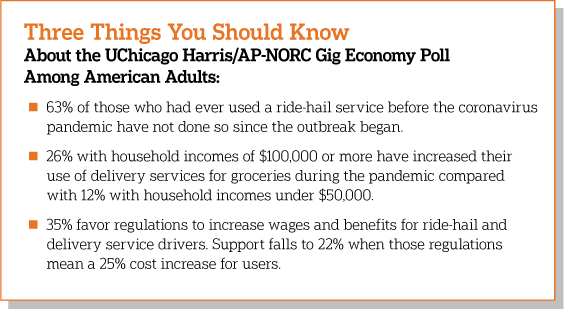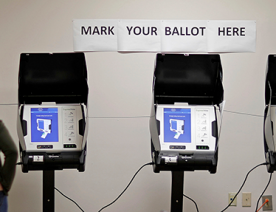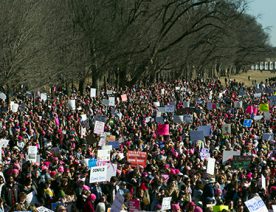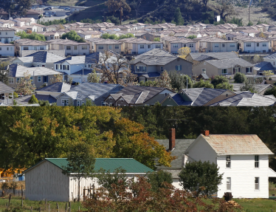
Published: August 19, 2020
Although the coronavirus has led to sharp declines in the use of ride-hailing services, there has been little change in the number of Americans using grocery and restaurant delivery services, according to a new study from the University of Chicago Harris School of Public Policy and The Associated Press-NORC Center for Public Affairs Research.
The survey shows the overall number Americans saying they use food and grocery delivery services has remained around 40% since the outbreak began. However, that includes 16% of people who are using food and grocery delivery services more frequently and 12% who are using them less often.
In contrast, the number who report using ride-hailing transportation services has fallen from 42% to 16%.

Few Americans are confident in the safety of working conditions for ride-hailing and delivery services workers, and the public views the safety risks of these jobs as similar to that of public transit or restaurant employees.
Although many Americans say they are not very comfortable using ride-hailing services, 71% of those who used ride-hailing services before the coronavirus outbreak expect to use them in a year.
Twenty percent of people who say they are extremely or very worried about contracting the coronavirus report using grocery delivery services more since the pandemic while only 7% of those who are not too or not at all worried about contracting the virus report such an increase.
Increased demand for delivery services is especially likely among Americans with higher household incomes. In particular, 26% of Americans with household incomes of $100,000 or more have increased their use of delivery services for groceries during the pandemic compared with 12% with household incomes under $50,000.
With the coronavirus outbreak, many Americans are not completely comfortable using delivery services, and more people are very comfortable picking up food from a restaurant than having it delivered (57% vs. 27%).
Despite the Americans’ safety concerns for themselves and gig workers, the public is relatively ambivalent about government regulations to boost wages or benefits for these drivers and delivery workers. In addition, support for such regulations drops if they lead to a large cost increase for customers.
Only 35% of Americans favor regulations to increase wages and benefits for ride-hail and delivery service drivers, while 14% oppose such regulations and 48% neither favor nor oppose it. Public support to increase wages and benefits for such drivers falls to 22% when the proposal includes a mention that those regulations would mean a 25% cost increase for users.
There is a stark partisan divide on the issue. Democrats are almost twice as likely to support government regulations to improve wages and benefits for ride-hail and delivery service drivers as Republicans, even when there is no mention of cost (44% vs. 28%).
The nationwide survey was conducted by the University of Chicago Harris School of Public Policy and The Associated Press-NORC Center for Public Affairs Research. The survey was conducted between July 16 and 20, 2020, using AmeriSpeak®, the probability-based panel of NORC at the University of Chicago. Online and telephone interviews using landlines and cell phones were conducted with 1,002 adults. The margin of sampling error is +/- 4.3 percentage points.
AP-NORC Center for Public Affairs Research. (August 2020). “Pandemic Disrupts Demand for Gig Economy Amidst Safety Concerns” [https://apnorc.org/projects/pandemic-disrupts-demand-for-gig-economy-amidst-safety-concerns/]







